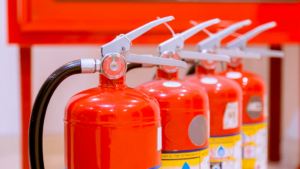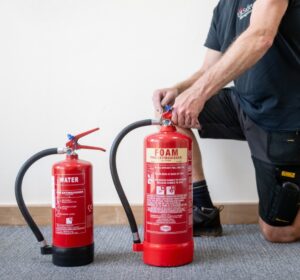
When it comes to safeguarding your premises against fire hazards, ensuring your fire extinguishers are in prime condition is non-negotiable. Fire Extinguisher Testing isn’t just about ticking a compliance box; it’s a critical step in ensuring readiness for emergency situations. From understanding the different types of extinguishers to navigating the maze of legalities and standards, there’s a lot to consider.
But where do you start? And what does the testing process actually involve? Stay with us as we explore these vital questions, offering insights and expert advice. And remember, if you’re feeling overwhelmed, we’re just a conversation away, ready to guide you through the maze.
Understanding Fire Extinguisher Types and Their Importance
Navigating the world of fire extinguishers can feel like deciphering a complex code, but it’s crucial to match the right type to your specific needs. Water extinguishers, ideal for Class A fires involving solid combustibles like wood and paper, are a staple in many environments. Foam extinguishers take it a step further, effectively tackling both Class A and B fires, the latter involving flammable liquids.
Powder extinguishers are versatile heroes, addressing Classes A, B, and even C fires, which involve gases. CO2 extinguishers are the go-to for electrical fires, leaving no residue and preventing damage to sensitive equipment.
Lastly, wet chemical extinguishers are specifically designed for Class F fires, commonly occurring in kitchens where oils and fats ignite. Each type has its niche, ensuring you’re well-prepared for the specific fire risks in your premises.
The Legalities and Standards of Fire Extinguisher Testing
In the UK, the foundation of fire safety, including extinguisher testing, is laid out by the Regulatory Reform (Fire Safety) Order 2005. This legislation mandates a ‘responsible person’ to ensure fire safety measures are in place and maintained, encompassing regular fire extinguisher inspections.
Compliance is further defined by British Standards, particularly BS 5306-3:2017, which specifies the maintenance and testing requirements for portable fire extinguishers. Adhering to these standards is not just about legal compliance; it’s a commitment to the safety and well-being of your employees and the protection of your property.
Regular testing and maintenance ensure that in the event of a fire, your extinguishers will function as intended, potentially saving lives and assets.
How Often Should Fire Extinguishers Be Tested?

Staying on top of fire extinguisher inspections and maintenance is pivotal for ensuring they’re ready to perform when it counts. At the very least, a visual inspection by the user should be a monthly ritual. This involves checking for any signs of damage, ensuring the extinguisher is accessible, and verifying the pressure gauge readings are within the safe zone. But that’s just the beginning.
Annually, a thorough check by a certified professional is non-negotiable. This isn’t merely about compliance; it’s about confidence in your equipment’s ability to protect when every
second counts. Adhering to these recommended intervals isn’t just a matter of ticking off a checklist; it’s a commitment to safety and operational readiness that shouldn’t be overlooked.
The Fire Extinguisher Testing Process: What to Expect
Embarking on the journey of fire extinguisher testing may seem daunting, but we’re here to simplify it for you. The process unfolds in meticulous steps to ensure your extinguishers are ready at a moment’s notice:
- Initial Inspection: We start with a thorough visual examination, checking for any signs of damage, corrosion, or obstructions.
- Pressure Checks: Ensuring the pressure gauge reads in the green zone is crucial for operational readiness.
- Weight and Seal Inspection: We verify the weight against manufacturer specifications and ensure seals are intact.
- Discharge Test: Conducted periodically, this test checks the extinguisher’s functionality and effectiveness.
- Refilling and Recharging: After discharge testing, we refill and recharge the extinguisher, restoring it to full operational capacity.
Choosing a Trusted Partner for Fire Extinguisher Testing
Selecting a reputable and certified provider for your fire extinguisher testing is crucial for ensuring the safety and compliance of your establishment. It’s not just about the service; it’s about entrusting your safety to a partner who understands the gravity of their responsibility.
Look for a provider adorned with accreditations like NICEIC, BAFE, and SafeContractor. These badges of honour signify a commitment to excellence and adherence to stringent safety standards. With such a partner, you gain not just professional expertise and reliable service, but also invaluable peace of mind, knowing that your safety is in expert hands.
Final Thoughts
In conclusion, the importance of rigorous fire extinguisher testing cannot be overstated. It’s an essential part of your fire safety strategy, ensuring protection and compliance. Choosing the right partner for this task, one that’s both reputable and accredited, is paramount. At UK Safety Management, we pledge to provide you with the utmost in service and peace of mind.
Get in Touch
If you’re seeking professional fire extinguisher testing to ensure the safety and compliance of your premises, we’re here to assist. At UK Safety Management, our dedicated team is on hand to provide expert guidance and support. For immediate assistance or to discuss your fire safety requirements, please ring us on 0333 016 3691.
Alternatively, you can reach out via email at [email protected]. We also invite you to utilise our contact form for any queries or to schedule a service. Our commitment is to offer you peace of mind with our comprehensive fire safety solutions.

